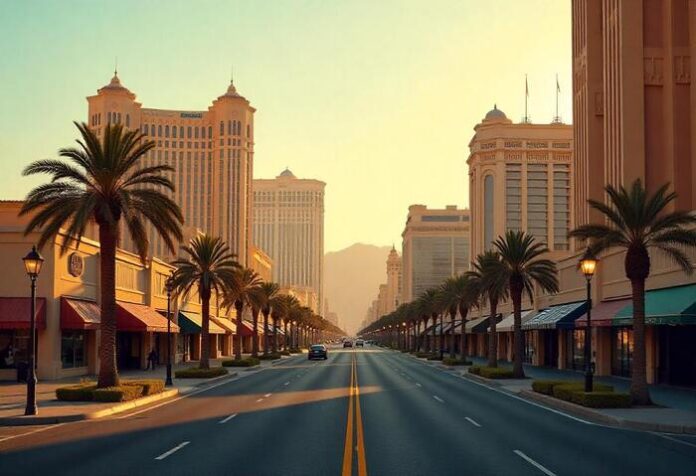Published on September 22, 2025

Las Vegas, long known as a global hub for entertainment, nightlife, and world-class resorts, is seeing a significant slowdown in visitor traffic. Throughout the first half of 2025, the city has experienced a consistent drop in arrivals, reflecting the combined impact of economic uncertainty, changing travel behaviors, and broader challenges facing the tourism sector. Rising concerns over the U.S. economy, coupled with cautious consumer spending and softer confidence levels, have prompted many travelers to reconsider vacation plans. Meanwhile, fewer large-scale conferences, a decline in international visitors, and the surge of online gaming and mobile sports betting are eroding the traditional attractions that once drew millions. Together, these factors are pushing Las Vegas toward what could be its steepest annual tourism decline in decades.
As a city synonymous with neon lights, high-stakes gaming, and headline-grabbing entertainment, Las Vegas has historically been a barometer for American leisure trends. Yet in 2025, long-standing patterns are shifting: data released in late July show six straight months of declining visitor numbers. This trend is not only a warning for the city’s hotel and casino sectors but also a reflection of broader economic and consumer behavior trends that are reshaping the U.S. travel landscape.
Visitor Numbers in Retreat
The first half of 2025 brought sobering news: total visitor volume dropped by 7.3% compared with the same period in 2024. June proved particularly difficult, as visitor arrivals fell by 11% year over year. Alongside this decline, hotel occupancy rates slipped, average daily room prices fell, and revenue per available room also weakened, a sharp contrast to the strong rebound that followed the pandemic years.
If the current trajectory continues, Las Vegas could witness the steepest annual decline since official tourism records began in 1970. This would surpass the challenges faced during the Great Recession, when visitation decreased 4.4% in 2008 and 3% in 2009. The severity of the drop underscores how vulnerable the city remains to fluctuations in consumer confidence and discretionary spending.
Mixed Performance Across Sectors
Not every indicator is in negative territory. Traffic volumes show that more people are arriving in Las Vegas by car, likely boosted by regional population growth and the city’s accessibility from nearby states. Likewise, gaming revenue on the Strip has remained resilient, continuing to edge upward despite fewer visitors overall. These gains, however, have not been sufficient to counterbalance the broader decline in hotel bookings and air travel arrivals.
The disconnect highlights an unusual situation: while locals and regional visitors are sustaining gaming revenues, the international and long-haul travel segments—traditionally vital for Las Vegas—are struggling. This imbalance is reshaping spending patterns across hotels, restaurants, and large-scale entertainment venues that depend heavily on out-of-town guests.
Wider Economic Signals
The dip in visitor traffic cannot be seen in isolation. Across the United States, job markets have softened and retailers are reporting weaker discretionary spending. Against this backdrop, the decline in Las Vegas travel suggests a tightening of household budgets, where non-essential leisure trips are often the first to be postponed or canceled.
By June 2025, Las Vegas had welcomed about 19.5 million visitors—significantly short of the pace needed to match previous years. If projections hold, this would mark the first annual decline outside of the pandemic period since 2017–2018, and potentially the largest percentage loss in the city’s history. For a destination often viewed as a gauge of America’s economic mood, this trend is a red flag.
Global and Cultural Pressures
Beyond domestic economic challenges, external forces are playing a role. International flight capacity into the United States has been reduced, limiting inbound travel from key markets such as Canada. Ongoing trade disputes and shifting diplomatic relations have added further strain, discouraging some foreign travelers from visiting.
Meanwhile, changing consumer habits are also influencing the city’s performance. The rise of online gaming platforms and sports betting apps means that many enthusiasts can now enjoy the Las Vegas experience from their living rooms. Younger generations, often more health-conscious and less inclined toward alcohol-fueled trips, are seeking different forms of entertainment, ranging from cultural experiences to outdoor adventures. These evolving preferences are reducing the appeal of traditional Las Vegas offerings.
A Critical Turning Point
Las Vegas has always been more than just a city—it is a symbol of risk-taking, reinvention, and America’s appetite for entertainment. Yet the latest figures suggest the destination is entering one of its most uncertain periods in over half a century. Declining visitor numbers, combined with shifting travel behaviors and global headwinds, are challenging the city’s ability to maintain its long-standing status as the ultimate playground for travelers.
The question now is whether Las Vegas can adapt. Innovation has been its hallmark, from pioneering mega-resorts in the 1990s to introducing global entertainment residencies in recent years. Looking ahead, the city may need to diversify further—expanding into cultural attractions, sustainable tourism, and tech-driven experiences that resonate with a new generation of travelers.
The Road Ahead
For now, the message is clear: what happens in Las Vegas is no longer confined to Nevada. The city’s fortunes mirror wider economic uncertainties and shifting global travel patterns. If 2025 ends with the sharpest visitor decline on record, it will serve as both a warning and a turning point for the tourism industry. Whether this marks a temporary setback or the beginning of a longer transformation remains to be seen, but one thing is certain—Las Vegas is once again being tested on its ability to evolve.
Las Vegas is experiencing a steep decline in visitor numbers in 2025, driven by economic uncertainty, weaker consumer confidence, fewer major conferences, and shifts in travel habits. These combined factors threaten the city’s tourism recovery and mark the largest drop in decades.
The sharp decline in Las Vegas visitor numbers highlights a pivotal moment for the city’s tourism industry. Economic uncertainty, shifting travel habits, and evolving entertainment preferences are converging to challenge the Strip’s traditional appeal. While the city has historically shown resilience, the trends in 2025 suggest that adaptation will be essential. From diversifying attractions to appealing to younger generations and international travelers, Las Vegas will need to innovate to restore its standing as a premier global destination. For now, the downturn serves as a clear signal that even America’s most iconic tourist hubs are not immune to broader economic and cultural shifts.

